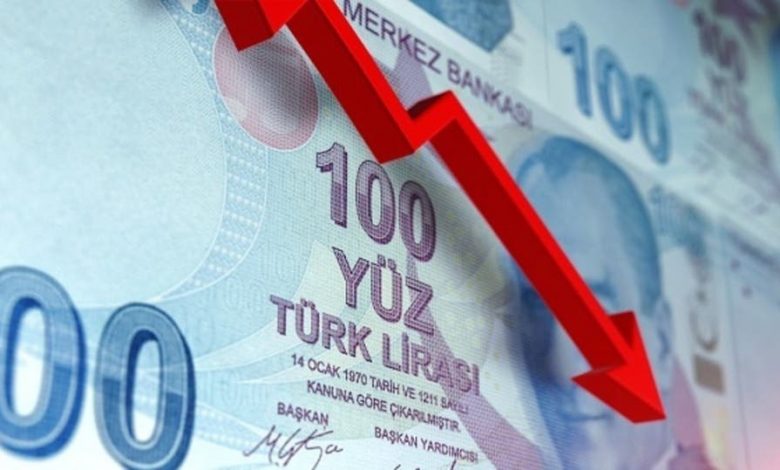The year 2024 is poised to be another critical period for Turkey’s economy, with the focus squarely on the “Turkish Lira Fluctuations” that have characterized recent years. Investors, businesses, and policymakers alike are keenly interested in understanding how the Turkish lira will perform against global currencies, particularly the U.S. dollar, and what factors will drive its value. In this article, we will analyze the causes of recent Turkish lira fluctuations, offer financial forecasts for 2024, and explore potential strategies for navigating these fluctuations.
The Causes of Turkish Lira Fluctuations

Understanding the “Turkish Lira Fluctuations” requires a deep dive into the myriad of factors that have influenced the currency’s value over the past decade. These fluctuations are the result of a combination of domestic economic challenges, external pressures, and geopolitical events.
Domestic Economic Challenges
Turkey’s domestic economic situation has been a significant driver of “Turkish Lira Fluctuations.” High inflation, large current account deficits, and concerns about the central bank’s independence have all contributed to the lira’s volatility.
High Inflation Rates
One of the primary domestic factors contributing to “Turkish Lira Fluctuations” is Turkey’s persistently high inflation rates. Inflation erodes the purchasing power of the lira, leading to a depreciation of the currency. As of the end of 2023, inflation in Turkey remained above target levels, raising concerns about the lira’s stability going into 2024.
Current Account Deficits
Turkey’s large current account deficits have also played a role in “Turkish Lira Fluctuations.” A current account deficit occurs when a country’s imports of goods and services exceed its exports, leading to an outflow of domestic currency to pay for foreign goods. This outflow puts downward pressure on the lira, contributing to its volatility.
Central Bank Independence
Concerns about the independence of Turkey’s central bank have further exacerbated “Turkish Lira Fluctuations.” When investors perceive that the central bank is subject to political pressure, they may lose confidence in its ability to control inflation and manage monetary policy effectively, leading to further weakening of the lira.
External Economic Pressures
In addition to domestic factors, external economic pressures have also been significant drivers of “Turkish Lira Fluctuations.” These include changes in global interest rates, commodity prices, and international trade relations.
Global Interest Rates
Global interest rates, particularly those set by the U.S. Federal Reserve, have a direct impact on “Turkish Lira Fluctuations.” When the Federal Reserve raises interest rates, it strengthens the U.S. dollar, making emerging market currencies like the Turkish lira less attractive to investors. This dynamic has been a key factor in the lira’s depreciation in recent years.
Commodity Prices
Fluctuations in global commodity prices, especially oil, have also contributed to “Turkish Lira Fluctuations.” Turkey is a net importer of energy, and higher oil prices increase the country’s import bill, leading to a weakening of the lira. Conversely, lower oil prices can provide some relief to the lira, but the overall impact depends on a range of other economic factors.
International Trade Relations
Turkey’s trade relations with key partners, particularly the European Union and the United States, have also influenced “Turkish Lira Fluctuations.” Tariffs, sanctions, and other trade-related issues can lead to volatility in the lira as investors react to changes in Turkey’s economic prospects.
Geopolitical Events
Geopolitical events, both within Turkey and in its broader region, have also contributed to “Turkish Lira Fluctuations.” Political instability, regional conflicts, and Turkey’s relationships with other countries can all impact investor confidence and the lira’s value.
Political Instability
Political instability in Turkey, including concerns about the rule of law, democratic governance, and human rights, has often led to “Turkish Lira Fluctuations.” When investors perceive that political risks are rising, they may choose to sell off Turkish assets, leading to a weakening of the lira.
Regional Conflicts
Turkey’s involvement in regional conflicts, such as in Syria and Libya, has also contributed to “Turkish Lira Fluctuations.” These conflicts create uncertainty and risk, leading to capital outflows and a depreciation of the lira.
Diplomatic Relations
Turkey’s diplomatic relations with other countries, particularly the United States and the European Union, have been another source of “Turkish Lira Fluctuations.” Diplomatic tensions can lead to economic sanctions or other measures that negatively impact the lira.
Financial Forecast for Turkish Lira Fluctuations in 2024

Given the complex array of factors influencing the lira, forecasting “Turkish Lira Fluctuations” for 2024 is a challenging task. However, by analyzing current trends and potential scenarios, we can offer some insights into what to expect in the coming year.
Scenario 1: Continued Volatility
One possible scenario for 2024 is that “Turkish Lira Fluctuations” will continue, driven by ongoing domestic and external challenges. If inflation remains high, the current account deficit persists, and political instability continues, the lira may experience further depreciation against the U.S. dollar and other major currencies.
In this scenario, the lira could continue to fluctuate within a wide range, with periods of sharp depreciation followed by temporary recoveries. Investors may remain cautious, and businesses operating in Turkey may need to adopt strategies to manage currency risk.
Scenario 2: Gradual Stabilization
A more optimistic scenario for 2024 is that “Turkish Lira Fluctuations” will gradually stabilize. This could occur if Turkey implements significant economic reforms, such as tightening monetary policy, reducing the current account deficit, and restoring investor confidence in the central bank’s independence.
In this scenario, the lira could experience a more gradual and sustained appreciation against the U.S. dollar, leading to reduced volatility. Investors may regain confidence in Turkish assets, and businesses could benefit from a more stable operating environment.
Scenario 3: Sharp Depreciation Due to External Shocks
A third scenario is that “Turkish Lira Fluctuations” could result in a sharp depreciation of the lira due to external shocks. For example, a sudden increase in global interest rates, a spike in oil prices, or a significant geopolitical event could lead to a rapid loss of confidence in the lira and a sharp decline in its value.
In this scenario, the lira could experience a sudden and severe depreciation, leading to increased inflation, higher borrowing costs, and significant economic challenges for Turkey. Investors and businesses would need to be prepared for heightened currency risk and increased uncertainty.
Predictions for Key Economic Indicators
To better understand the potential impact of “Turkish Lira Fluctuations” in 2024, it is important to consider predictions for key economic indicators, including inflation, interest rates, and economic growth.
Inflation
Inflation is likely to remain a key concern in 2024, with “Turkish Lira Fluctuations” playing a significant role in determining the inflation rate. If the lira continues to weaken, import prices could rise, leading to higher inflation. Conversely, if the lira stabilizes or appreciates, inflationary pressures could ease somewhat.
Current forecasts suggest that inflation in Turkey could remain elevated in 2024, particularly if “Turkish Lira Fluctuations” continue to drive up import costs. However, a more stable lira could help bring inflation closer to the central bank’s target range.
Interest Rates
Interest rates in Turkey are also likely to be influenced by “Turkish Lira Fluctuations” in 2024. If the lira continues to depreciate, the central bank may be forced to raise interest rates to defend the currency and control inflation. However, higher interest rates could also slow economic growth and increase the cost of borrowing for businesses and consumers.
Conversely, if the lira stabilizes, the central bank may have more room to lower interest rates, which could support economic growth. However, any reduction in interest rates would need to be carefully managed to avoid reigniting inflationary pressures.
Economic Growth
Economic growth in Turkey in 2024 will likely be influenced by the extent of “Turkish Lira Fluctuations.” If the lira remains volatile, businesses may face higher costs and reduced profitability, leading to slower economic growth. In addition, high inflation and rising interest rates could weigh on consumer spending and investment.
On the other hand, if the lira stabilizes, economic growth could receive a boost as businesses regain confidence and investment increases. However, the pace of growth is likely to depend on the broader global economic environment and Turkey’s ability to implement effective economic policies.
Strategies for Navigating Turkish Lira Fluctuations in 2024

Given the uncertainty surrounding “Turkish Lira Fluctuations” in 2024, it is important for investors, businesses, and policymakers to adopt strategies for navigating potential risks and opportunities.
For Investors
Currency Hedging
One effective strategy for managing the risks associated with “Turkish Lira Fluctuations” is currency hedging. By using financial instruments such as forward contracts, options, and futures, investors can protect themselves against adverse movements in the lira. Hedging can help reduce currency risk and provide more predictable returns on investments.
Diversification
Another important strategy for investors is diversification. By spreading investments across different asset classes, sectors, and regions, investors can reduce their exposure to any single source of risk, including “Turkish Lira Fluctuations.” Diversification can help balance risk and reward, providing a more stable investment portfolio.
Long-Term Perspective
Investors may also benefit from adopting a long-term perspective when dealing with “Turkish Lira Fluctuations.” While short-term volatility can be challenging, a long-term view may allow investors to take advantage of opportunities that arise during periods of market turbulence. By focusing on the fundamentals and maintaining a disciplined investment approach, investors can potentially achieve their financial goals despite currency fluctuations.
For Businesses
Pricing Strategies
Businesses operating in Turkey can also take steps to manage the impact of “Turkish Lira Fluctuations” on their operations. One important strategy is to implement flexible pricing strategies that account for changes in currency value. By adjusting prices in response to lira movements, businesses can help protect their margins and maintain competitiveness in the market.
Cost Management
Another key strategy for businesses is cost management. By carefully managing costs, particularly those related to imports and raw materials, businesses can mitigate the impact of “Turkish Lira Fluctuations” on their profitability. This may involve negotiating better terms with suppliers, seeking out local alternatives, or implementing efficiency improvements.
Risk Management
Businesses should also implement comprehensive risk management strategies to navigate “Turkish Lira Fluctuations.” This may include using financial instruments to hedge against currency risk, diversifying revenue streams, and maintaining a strong balance sheet. Effective risk management can help businesses remain resilient in the face of currency volatility and other economic challenges.
For Policymakers

Monetary Policy
Policymakers in Turkey have a critical role to play in managing “Turkish Lira Fluctuations.” One of the most important tools at their disposal is monetary policy. By setting interest rates and managing the money supply, the central bank can influence the value of the lira and help control inflation. Policymakers must strike a balance between supporting economic growth and maintaining currency stability.
Fiscal Policy
Fiscal policy is another important lever for managing “Turkish Lira Fluctuations.” By controlling government spending and taxation, policymakers can influence the broader economy and help address imbalances that contribute to currency volatility. Responsible fiscal management can help restore investor confidence and support a more stable lira.
Structural Reforms
Finally, structural reforms are essential for addressing the underlying causes of “Turkish Lira Fluctuations.” These may include measures to improve the business environment, enhance transparency and governance, and reduce economic vulnerabilities. By implementing meaningful reforms, policymakers can help create a more stable and resilient economy, reducing the likelihood of future currency fluctuations.
Conclusion
As we look ahead to 2024, “Turkish Lira Fluctuations” are likely to remain a key concern for investors, businesses, and policymakers. While the future of the lira is uncertain, understanding the factors driving its fluctuations and adopting effective strategies for managing currency risk can help navigate the challenges and opportunities that lie ahead. Whether the lira stabilizes, continues to fluctuate, or faces further depreciation, a proactive approach to managing currency risk will be essential for achieving financial success in the coming year
اتجاه الليرة التركية مقابل الدولار الأمريكي: تحليل التحركات الأخيرة والتوقعات المستقبلية
Turkish Lira Trends: Expert Forecasts on Possible Future Declines

